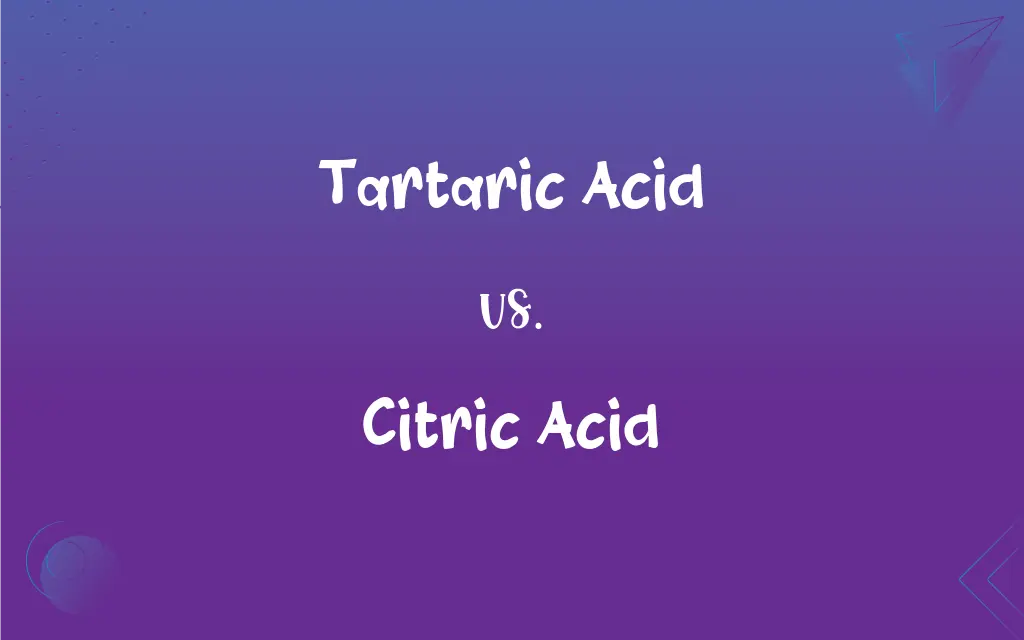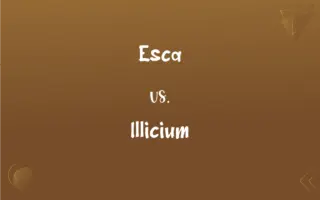Tartaric Acid vs. Citric Acid: What's the Difference?
Edited by Aimie Carlson || By Janet White || Published on March 26, 2024
Tartaric acid is a primary acid in wine; citric acid is found in citrus fruits. Both are used as food additives.

Key Differences
Tartaric acid and citric acid are both organic acids with distinct sources and applications in food and other industries. Tartaric acid is a key acid in grapes and wines, giving them a characteristic taste, while citric acid, predominant in citrus fruits like lemons and oranges, is widely used for its sour flavor and as a preservative. Despite their common use as acidity regulators, each acid contributes uniquely to the flavor profile and stability of food products.
Tartaric acid plays a crucial role in winemaking, acting as a stabilizing agent and influencing the wine's color and taste. In contrast, citric acid is essential in the food industry, not just for its flavor but also for its ability to preserve the color and texture of foods. The presence of tartaric acid is particularly notable in the process of fermentation in wines, whereas citric acid is often added to beverages, candies, and canned foods to enhance acidity and prevent spoilage.
Chemically, tartaric acid and citric acid differ in their molecular structure, which affects their reactivity and interactions with other substances. Tartaric acid's ability to form stable salts, known as tartrates, is valuable in baking powder and as an emulsifier in food products. Citric acid, on the other hand, is a key intermediate in the citric acid cycle (Krebs cycle), crucial for energy production in living organisms, and is used in pharmaceuticals and cosmetics for its antioxidant properties.
The solubility of tartaric acid and citric acid in water and other solvents also varies, influencing their use in different applications. Tartaric acid's specific optical activity is exploited in several industrial applications, including the synthesis of chiral compounds. Citric acid's versatility extends beyond food and beverages, being utilized in cleaning agents for its ability to bind with metals and soften water.
Both tartaric acid and citric acid are important food additives that contribute sourness and stability to food and drinks, their distinctive characteristics and applications stem from their unique chemical properties, sources, and roles in nature and industry.
ADVERTISEMENT
Comparison Chart
Natural Source
Grapes, wine
Citrus fruits like lemons, oranges
Main Use
Winemaking, food stabilizer
Food additive, flavoring, preservative
Chemical Structure
Dihydroxy dicarboxylic acid
Trihydroxy tricarboxylic acid
Industrial Application
Baking powder, emulsifier
Pharmaceuticals, cosmetics, cleaning agents
Role in Nature
Fermentation process in wines
Key in citric acid cycle, energy metabolism
ADVERTISEMENT
Tartaric Acid and Citric Acid Definitions
Tartaric Acid
A natural organic acid found in grapes.
Tartaric acid contributes to the tart taste of grapes.
Citric Acid
Plays a crucial role in the citric acid cycle.
Citric acid is vital for cellular energy production in metabolism.
Tartaric Acid
Used as an acidulant in wine making.
Tartaric acid stabilizes wine by preventing crystallization.
Citric Acid
A weak organic acid present in citrus fruits.
Citric acid gives lemons their characteristic sourness.
Tartaric Acid
Influences the color and taste of wines.
The tartaric acid level is crucial for the wine's final flavor profile.
Citric Acid
Widely used as a food preservative and flavoring agent.
Citric acid is added to sodas to enhance their tart flavor.
Tartaric Acid
Forms stable salts known as tartrates.
Tartaric acid is used to create cream of tartar.
Citric Acid
Utilized in pharmaceuticals for its antioxidant properties.
Citric acid is found in effervescent tablets to aid absorption.
Tartaric Acid
Acts as an emulsifier in food products.
Tartaric acid is added to baking powder to improve its stability.
Citric Acid
Employed in cleaning products for its chelating properties.
Citric acid is used in descaling agents to remove limescale.
FAQs
What is tartaric acid?
Tartaric acid is an organic acid primarily found in grapes and wine, used in food and beverage production for its stabilizing and flavoring properties.
What is citric acid?
Citric acid is a natural acid found in citrus fruits, widely used in the food industry as a preservative, flavor enhancer, and in various industrial applications.
Are tartaric and citric acids natural?
Both acids occur naturally in fruits, with tartaric acid mainly in grapes and citric acid in citrus fruits.
How do tartaric acid and citric acid differ in winemaking?
Tartaric acid is intrinsic to the wine's acidity and stability, whereas citric acid, though less common, can be used for acidity adjustments.
Can both tartaric and citric acid be used in baking?
Yes, both are used in baking; tartaric acid as part of baking powder and citric acid to enhance sour flavors.
Is tartaric acid harmful?
In typical food and wine consumption levels, tartaric acid is safe, though excessive intake can lead to health issues.
What are the health effects of consuming tartaric acid?
Consumed in moderation, tartaric acid is generally safe, though excessive amounts can lead to digestive issues.
What role does tartaric acid play in food besides winemaking?
It acts as an emulsifier and stabilizer in baked goods and confections.
Can citric acid cause allergies?
While uncommon, some individuals may experience sensitivity or allergies to citric acid.
Are there synthetic versions of tartaric or citric acid?
Citric acid is often produced via microbial fermentation, while synthetic tartaric acid is less common but can be manufactured chemically.
Can you substitute tartaric acid for citric acid in recipes?
Substitutions can be made, but they may affect the final taste and texture due to differing acid strengths.
What is the significance of citric acid in metabolism?
Citric acid is a key intermediate in the citric acid cycle, essential for energy production in cells.
Can citric and tartaric acids be found in non-food products?
Yes, they are used in cosmetics, pharmaceuticals, and cleaning products for various functional and aesthetic purposes.
How does citric acid benefit the food industry?
Citric acid is valued for its preservative qualities, pH adjustment, and flavor enhancement in a wide range of products.
How do tartaric and citric acid contribute to the flavor of food and drinks?
They enhance flavors by adding acidity, which can balance sweetness and enrich overall taste profiles.
How is citric acid produced industrially?
It is primarily produced through fermentation processes using specific strains of mold.
Do tartaric and citric acids affect the antioxidant properties of foods?
Yes, both can act as antioxidants to preserve food color and prevent spoilage.
Why is tartaric acid important in the pharmaceutical industry?
While less prominent than citric acid, tartaric acid is used in some pharmaceuticals for its chiral properties and as an acidulant.
How does citric acid function in cleaning products?
Its ability to chelate metals makes it effective in removing scale and brightening metals.
What are the environmental impacts of tartaric and citric acid production?
The environmental impact varies with the production process, but biotechnological production methods are generally considered sustainable.
About Author
Written by
Janet WhiteJanet White has been an esteemed writer and blogger for Difference Wiki. Holding a Master's degree in Science and Medical Journalism from the prestigious Boston University, she has consistently demonstrated her expertise and passion for her field. When she's not immersed in her work, Janet relishes her time exercising, delving into a good book, and cherishing moments with friends and family.
Edited by
Aimie CarlsonAimie Carlson, holding a master's degree in English literature, is a fervent English language enthusiast. She lends her writing talents to Difference Wiki, a prominent website that specializes in comparisons, offering readers insightful analyses that both captivate and inform.







































































